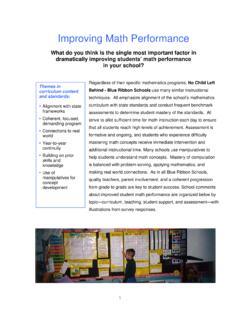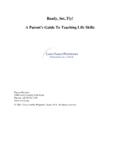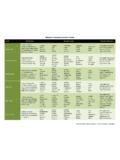Transcription of Learner Characteristics and Motivation: How to Achieve ...
1 Learner Characteristics and Motivation: How to Achieve Efficient and Effective Learning 2015 CELT Vol. VIII Catherine Marie Fraser Bates Queens University During the Society for Teaching and Learning in Higher Education Conference 2014, a workshop was held three consecutive times as part of the Pedagogical Speed Dating sessions to introduce experienced college/university faculty and instructional designers to an approach to instructional design that is based on increasing motivation. The purpose of the workshop was to demonstrate the use of Keller s ARCS Model of Instructional Design for Motivation, specifically how to Achieve effective Learner / Learner , Learner /content, and Learner /teacher interaction.
2 The discussion focusses on the experiences of typical university and college students. Introduction Aim his paper is based on a 30 minute workshop delivered in three consecutive sessions at the Society for Teaching and Learning in Higher Education Conference 2014 as part of the Pedagogical Speed Dating sessions. The aim of the session was to explore instructional design as a method of matching Learner /teacher Characteristics (motivation, experience, age, attitude, learning style, and background education) to the content. The context for the discussion was motivation of the typical university and college student with the objective to make recommendations for instructional strategies that would suit their Characteristics .
3 Constructivist conditions for learning was the frame within which the discussion was held. Background The use of the traditional lecture method is still prevalent in many universities and colleges today. The lecture method is a viable instructional strategy for intrinsically motivated ( how can I use my learning to better myself ) learners with life experiences, who are reflective or theoretical learners. It is suited to subject matter best delivered according to the behaviourist philosophy (stimulus, response, reinforcement). The lecture format may be less helpful for young students who are extrinsically motivated ( what s in it for me ), who have limited life experiences, who are practical or active learners, and who must learn content that doesn t have just one right answer.
4 A constructivist philosophy may be called for in this case, which represents a paradigm shift for students from being passive recipients of instruction that has been designed for them, to being actively involved in T 165 Collected Essays on Learning and Teaching, Vol. VIII determining what their own learning needs are and how those needs can best be satisfied. This paper and the preceding workshop offers an opinion of how a theory of motivation can be used to match instructional strategies to Learner Characteristics . Discussion Learner Characteristics The traditional university and college student can be classified as a young adult chronologically; however, due to their limited life experiences and dependence on external motivation ( , rewards in the form of grades for work assigned by a teacher in topics not of their choosing) up to this stage in their learning career they are more similar to young learners.
5 The typical university and college student must Achieve a university degree to be accepted into their future profession which can be argued does set the conditions for intrinsic motivation ( goals that arise from within), however the case can equally be made for extrinsically motivated students who are aware that a degree or diploma are the entry level qualifications for their future work but who are living in the present and struggling to balance part-time work, parental expectations and the unfamiliar university/college culture potentially limiting their experience to short term goals based on the extrinsic rewards of grades. The differences between intrinsic (self-motivated) and extrinsic (external) motivation are important when choosing suitable reward systems (assessment types and criteria) and instructional strategies (conditions for learning).
6 Support For some university/college students, it is necessary to generate intrinsic motivation to Achieve a level of effort justification. Effort justification is the tendency to assign more value to an outcome that one has had to put great effort into achieving (Bandura, 1991). Conversely, outcomes that have rewards assigned by others are less motivating. The social cognitive concept of cognitive evaluation theory (CET) proposed by Eisenberg, Deci, Koestner, & Ryan (1999), asserts that underlying intrinsic motivation are the psychological needs for autonomy and competence, so the effects of an event such as a reward depends on how it affects perceived self-determination and perceived competence (p.)
7 628). This theory is the best way to explain how to Achieve efficient and effective learning in this group. The traditional university instructional strategy, less so in colleges, is the lecture method with the traditional reward a grade achieved in exchange for doing a certain amount of work to a certain standard assigned by the professor. While suitable for reflective learners, the lecture method puts those with other learning styles at a disadvantage. Good instructional design should include a selection of instructional strategies to motivate most students most of the time to Achieve good academic results. One example is the use of a learning contract that assigns a range of assessments and a range of grades that the students sign-up to Achieve .
8 A student can contract with the professor at the beginning of the term to receive either an A, a B, or a C grade in exchange for predetermined products with quality and quantity described in a rubric. Once the contract is agreed upon between student and teacher, it is up to the student to uphold his or her end of the bargain. The motivation to learn is now placed firmly in the hands of the student. The student decides what level of reward they will receive from their level of effort (effort justification) and Learner performance is not undermined by the traditional conditions of the classroom reward system (Eisenberg, Deci, Koestner, & Ryan, 1999, p.)
9 629). Motivation is increased in a population that, although chronologically classed as adult , is more similar to younger more extrinsically motivated learners. 166 Learner Characteristics and Motivation Application Effort, performance, and consequence (Weibelzahl and Kelly, (2005), p. 81) is shown in the model below as the output of the Learner and the organization (Figure 1). This model reflects the traditional self-directed conditions for learning of attention, effort, participation, and persistence (Garrison, 1997). Students bring their inputs while the learning organization supplies the environmental factors.
10 Figure 1 An Adaptation of Motivation Theory by Keller (1983) adapted by de Vincent (2003) in Weibelzahl and Kelly (2005) Instructional Design to Support Learning Characteristics and Motivation The theory and practice of instructional design is complex, however, the SERC Portal for Educators called Pedagogy in Action (accessed through Carleton University s Faculty Development site at ) has an excellent section on Teaching Methods that will apply the environmental factors of motivation, learning, and contingency design and management. If environmental factors are considered to be externally controlled, then expectancy theory fits into this model as an approach to designing for extrinsically motivated learners.


















